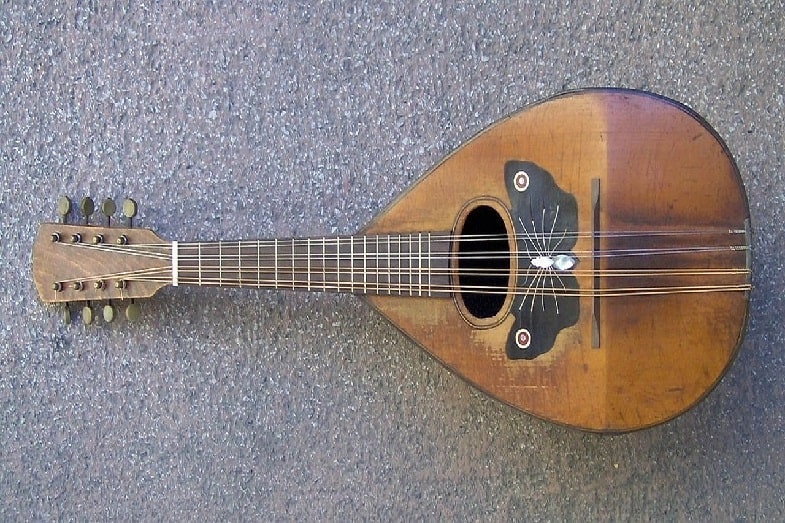Mandolin vs banjo – how do they compare? Mandolins and banjos are both stringed instruments, similar to a guitar. But there are many differences between them. In this article, I will describe the differences between a banjo vs mandolin as well as their features.
Mandolins and banjos both have a soundboard, neck, and strings. The main differences between them are as follows:
- Mandolins have shorter necks than banjos. The neck of a mandolin is closer to a tenor violin’s neck length, while the neck of a banjo is similar to the neck length of a guitar.
- Mandolins have eight strings, while banjos can have four to six strings, the most common of which is six.
- Mandolins have a pear-shaped body, while banjos have exclusively round bodies.
- It is easier to play the banjo than to play the mandolin.
- Mandolins produce higher-pitched sounds, while banjos produce soulful, twang sounds.
As you can see, there are several differences between these two instruments. You have to consider these differences if you are thinking of choosing which one you want to play.
Read on to learn more about the mandolin vs banjo so that you can choose which you might prefer to learn.
Also, we hope you find the links here useful. We may get a commission if you purchase something through a link on this page, so thank you!
Mandolin Vs Banjo
If you don’t know what to choose between a mandolin and a banjo, consider their differences. The different parts of these instruments that we will compare are as follows:
- Sound
- Strings
- Application or where they are commonly played
- Pitch
- Neck
- Body
Let us discuss these differences one by one:
1. Sound
A mandolin’s sound is akin to the sound of a guitar – only with a high pitch. When you pluck or strum the strings, the sound is just like plucking or strumming a guitar. However, the sound’s pitch or tone is limited to the higher octaves or tone ranges.
The sound of a banjo, on the other hand, is soulful and twangy. It also has an element of lift to its sound. Perhaps it is the reason why they are used in the accompaniment of western-type songs and dances.
2. Strings
There are four sets of strings in the mandolin. In other words, it has a total of eight strings. They are coupled strings, meaning every two of the eight strings have the exact pitch. This setup is the reason for the unique timbre of mandolins.
The banjo, meanwhile, only has four or five strings. Banjo players typically use their fingers or a pick or plectrum to pluck or strum the strings. There are many strumming and plucking techniques used in playing banjos. Mandolin players mostly use picks to strum or pluck the instrument.
3. Application
One of the biggest differences when choosing to learn the banjo or mandolin is the type of music you like to listen to and play.
Musicians that play secular songs typically use the mandolin. You can hear them played by musicians singing patriotic songs. Banjos, on the other hand, are often heard in country and folk music events. You’ve probably heard them play in some western movies that you’ve seen in the past.

4. Pitch
Mandolins are typically tuned lower than banjos. Strings of mandolins are also spaced in musical intervals of a fifth. The pitch tones of mandolins are also higher than those of the banjos.
Additionally, there are more variations or modifications in the banjo’s string arrangements than in the mandolin. Banjos with five strings are commonly tuned in fourths. The Irish banjo and the tenor banjo, which are four-string banjos, are also tuned in fourths.
5. Neck
The neck of a banjo is long and similar to the length of a typical guitar neck. But the neck of a mandolin is short and similar to the length of a tenor violin. Moreover, both necks of the mandolin and banjo are divided into several frets. The frets in a mandolin are shorter than the frets in a banjo.
Additionally, the neck of the banjo is thinner than that of the mandolin. A mandolin neck has to be thick because it has to accommodate a total of eight strings.
6. Body
It is in their bodies where these two instruments largely differ. A mandolin’s body is tear-shaped or pear-shaped, while a banjo’s body is almost always circular in shape. Both bodies are hollow to enable the instruments to produce sound when their strings are strummed or plucked.
The body of a banjo has a flat bottom. Its top is usually covered by animal skin, just like what you see in snare drums. Most banjos have bottom covers that are flat. But some banjos have open bottoms, meaning there is no covering at the back.
Most mandolins’ bodies have flat tops with some small openings to enable the reverberation of the sound as the strings are plucked or strummed. Their bottoms are usually circular-shaped that curve inward. They are mostly made of spruce, maple, or other types of hardwood. There are no mandolins that have open bottoms.
We’ve discussed mandolin vs banjo. Next, let’s look at the history, sound quality, and music style of each instrument. Once you know the differences between each, you will be able to choose one to learn – the mandolin or banjo.
What Is a Mandolin?
Click here to see this mandolin on Amazon.
Early History
Very simply, the mandolin is a small musical instrument that has eight strings and looks like a lute. Someone developed it in Italy in the 18th century. From then on, it has become a popular instrument used in many musical styles around the planet. Bluegrass, classical, and even jazz musicians are playing this instrument.
There are similar instruments that have preceded the mandolin by many centuries. They are called mandore, mandola, and mandora. The mandora was first developed in Italy in the 15th century. It had only four strings at that time. Historians believe that its name was lifted from mandorla or almond. This term was later used to refer to mid-sized mandolins.
Sound Quality
The mandolin has a soundboard, a raised fretboard, and eight metal strings, which are coupled strings. Each pair of strings is tuned in precisely the same pitch. In other words, even if this instrument has eight strings, it only produces four pitches. These strings are tuned as violin strings are tuned. The pitches are G, D, A, and E, going from high to low.
The new designs of mandolins produce guitar-like sounds. This quality makes them better suited for strumming than the mandolins with bowl-like backs. Some believe that the newer designs have sacrificed the traditional sweeter tones of Italian-style mandolins.
But others say that the modifications have achieved a sharper attack and greater sound projection. These two sound qualities played a great part in enhancing the role of the mandolin in bluegrass music. In the United States, flatback mandolins are more popular, while in other parts of the world, it is still the bowl-back mandolins that reign supreme.
Music Style
The style of music associated with the mandolin is aptly represented by the theme song of The Godfather movie. If you have never heard its sound before, just listen to this music and you will understand its music style. It is the type of music that you will hear in any Italian restaurant.
However, in the United States, the mandolin is closely associated with bluegrass music. It is almost always accompanied by other musical instruments, such as the banjo, guitar, fiddle, and bass. Moreover, it is one of the core elements of the bluegrass sound.
In bluegrass music style, the mandolin usually plays full chords, animated solos, and unusual techniques that can’t be done by the traditional mandolin. Mandolin music has also been adapted to a variety of music styles in modern times.
These music styles include country folk, Brazilian music, pop-jazz, and folk music of other countries. A reason for this can be partly attributed to its similarity to the violin, especially in the matter of pitch tuning.
Body Parts
While it may look similar to a guitar, the mandolin is quite different. Unlike the guitar with a fixed bridge, the mandolin has a movable bridge. Mandolin players can make small tuning adjustments with this setup. The thing that holds the bridge in place is the tension from the strings.

The eight strings of the instrument go over the bridge and across its neck. Also, the mandolin’s neck is relatively short and extends out from its body. It has two parts: the fingerboard and the frets. The fingerboard is thin flat wood attached to the neck, while the frets are thin metal strips embedded into the fingerboard.
Click here to see this Donner A Style Mandolin on Amazon.
What Is a Banjo?
Click here to see this Kmise Banjo Ukulele Concert Size on Amazon.
The banjo is a stringed musical instrument with a circular drum-like body. Banjos can have anywhere from 4 to 6 strings.
Early History
Historians believe that this instrument evolved from West African slaves’ instruments brought over to the Caribbean from the continent of Africa in the 17th century.
Some also believe that the word banjo was lifted from mbanza, an African string instrument. This mbanza was believed to be copied from banza, a five-string instrument from Portugal. This instrument looks similar to a lute.
Another version of the story says that the word banjo was taken from bandore or bandurria, another Portuguese instrument. And yet another story says that it is not taken from a musical instrument but from an Afro-Caribbean folk dance called banya.
Regardless of the word’s etymology, it was in the 18th century when the banjo appeared in written references. By the 19th century, the banjo became commercially available.
Traditional Banjo Pot
The banjos inspired by the African slaves were built from gourd bodies with a wooden stick as the neck. There were four or five strings fitted on these early banjos.
In the 1830s, the precursor to the modern banjos was introduced. The gourd bodies were replaced by a sound box that looked like a drum. It also had four full-length strings and a shorter fifth string.
Modern Banjo
The pot or the sound box of a modern banjo is made of a circular rim of metal or wood. This pot also has a tension head like that of a drum. Traditionally, the head is covered with animal skin. Today, synthetic materials have replaced animal skin.
Traditional banjo strings are made of metal. But over time, mandolin makers have found a way to use nylon strings to replace steel strings. In the early days, gut strings were used when nylon strings were not yet common. Non-metal strings produce vintage-sounding and mellower tones.
Banjos are tuned differently than guitars. They are typically tuned by using friction tuning pegs or planetary gear tuners. Guitars are tuned using a worm gear mechanism, which is an integral part of the head. But lately, there are banjo varieties with six strings that have the same tuning system of guitars.
Click here to see this Vangoa Banjo Uke on Amazon.
Conclusion – Banjo Vs Mandolin
Mandolin vs banjo – how do they compare? These two musical instruments share three things in common. Both have a soundboard, neck, and strings.
But they’re also different from each other in many aspects. The main differences between them are:
- Mandolins have shorter necks than banjos. The neck of a banjo is similar to the neck length of a guitar. However, the neck of a mandolin is closer to the neck length of a tenor violin.
- Mandolins have eight strings, while banjos can have four to six strings, the most common of which is six.
- Mandolins have a pear-shaped body, while banjos have exclusively round bodies.
- It’s more difficult to learn how to play the mandolin than the banjo.
- Mandolins produce higher-pitched sounds, while banjos produce soulful, twang sounds.
Now that you know the differences, you can choose between a mandolin or banjo. You will have a better understanding of what you need to consider when choosing which instrument is suited for what you have in mind.
Related reading:
How to Tune a Banjo? [5-String and 4-String Banjo Tuning]
How to Play Banjo – 10 Tips for Beginners









